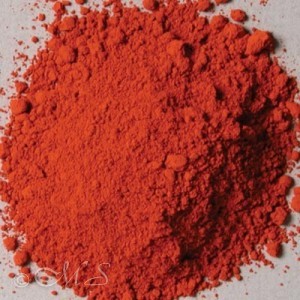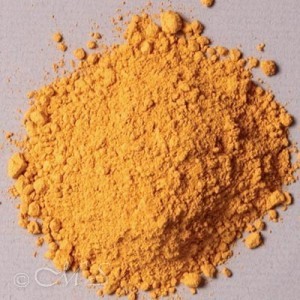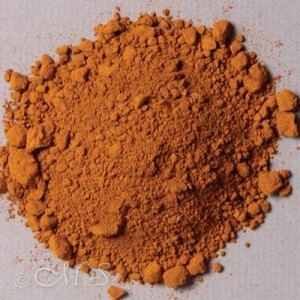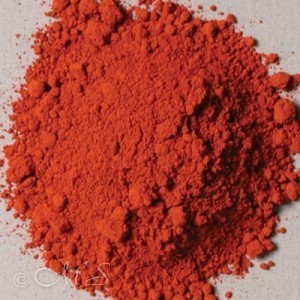George O’Hanlon’s Best Painting Practice Class held in Portland this past weekend was a treasure trove of valuable information. Much of the information presented was material I have studied over the years since my art quest began, and happily, there were many nuggets presented too. The topics of materials, techniques, mediums, oil painting substrates, pigments, solvents, linens, longevity, and brushes are all endlessly fascinating for me, and I never lose my desire to learn more. I especially enjoyed the section on pigments, both historical and modern, and it was reassuring to learn that the pigments I have been using in my Lessons Projects are some of the most light-fast and highly saturated colors.
Mostly these encompass the list of natural oxides. They are found in quarries all over the world and have been used throughout history. Some samples of these beguiling and beautiful hues are:
 Ercolano red is a natural earth containing clay tinted by iron oxide and is found in deposits near Ercolano, Italy. Ercolano was named Herculaneum until 79 AD and Resina until 1969. As you can see, this is one of the warmest natural oxide pigments and is delightful to use. It has a slightly gritty consistency, which enhances the sparkle on the surface of the canvas.
Ercolano red is a natural earth containing clay tinted by iron oxide and is found in deposits near Ercolano, Italy. Ercolano was named Herculaneum until 79 AD and Resina until 1969. As you can see, this is one of the warmest natural oxide pigments and is delightful to use. It has a slightly gritty consistency, which enhances the sparkle on the surface of the canvas.
 Lemon Ocher is a natural yellow iron oxide that is transparent, never fades in daylight, and the color is highly concentrated. It is mined in quarries in northern Italy. This splendid pigment has been known since antiquity and is widely used by artists. It is one of my most useful colors.
Lemon Ocher is a natural yellow iron oxide that is transparent, never fades in daylight, and the color is highly concentrated. It is mined in quarries in northern Italy. This splendid pigment has been known since antiquity and is widely used by artists. It is one of my most useful colors.
 French Natural Yellow Iron Oxide could be compared to a raw sienna shade. This pigment is also exceptionally versatile. I use it in the shadow mixtures of flowers and the stamens too. This one is found in the quarries in the heart of Luberon Massif in ocher country and has also been used throughout history.
French Natural Yellow Iron Oxide could be compared to a raw sienna shade. This pigment is also exceptionally versatile. I use it in the shadow mixtures of flowers and the stamens too. This one is found in the quarries in the heart of Luberon Massif in ocher country and has also been used throughout history.
 Pozzouli Red Earth is also a natural earth pigment containing clay tinted by iron oxide found in deposits near Pozzouli, Italy. The iron oxide and mineral content can vary the color of the red ocher from deep red to brownish red. This pigment is found around the world and has also been used since prehistory.
Pozzouli Red Earth is also a natural earth pigment containing clay tinted by iron oxide found in deposits near Pozzouli, Italy. The iron oxide and mineral content can vary the color of the red ocher from deep red to brownish red. This pigment is found around the world and has also been used since prehistory.
You can quickly see the compatibility of these pigments, which are made naturally harmonious by the earth’s processes. They are subtle in color and not garish at all like some of the modern synthetic pigments. All iron oxides can be intermixed with each other safely, have moderate to fast drying periods, and are lightfast. They are considered non-toxic but as usual, normal safety precautions are recommended. All can be found at Natural Pigments. Check out the Painting Best Practices class next time it comes to your area. You will be impressed with the scope of the information presented.
Have any of you used these pigments? What has been your experience? Leave a comment and let the readers know.

Hi Margret,
Great post. Not only did I learn lots about the pigments, I felt like I’d just been on a tour of Italy! Grazie, Margret!
Baci-Baci,
Gary, and Michelina, too.
Aloha Gary and Michelina, Glad you enjoyed your tour, though it was vicariously. Some of these Italian pigments are so splendid that it is fun just to make swatches and see what happens. Hope all is well in the sun. Margret
Gary and Michelina, So glad you enjoyed the trip to Italy, though vicariously. How’s things in the sunny part of the world? Margret
Seems like a long wait for this blog but it’s such a delight that it is worth the wait.
Judy, Glad you liked the story of the Italian pigments. I will try to post more often! Margret
Margret, it’s always a pleasure to catch up on your adventures. We feel the same way about these earth pigments. Sometimes they appear just so subtly beautiful that you forget about all those radiant high chroma hues. Natural Pigments does a great job of sourcing so many of these pigments but next month I may get the chance to go to another source, Dr. Kremer in Aichstetten. My wife is nearby in Kempten until June so I plan to make the pilgrimage. I could have a thousand questions but I think I’ll just play it by ear.
What would be on the top of your list? I’m thinking about cinnabar or lead tin yellow.
Hello Sander, Excuse the long delay for my reply, but I have been on an extended odyssey from the west coast, down south, and nearly all the way to the east coast. San Antonio was a major destination to attend the Salon International at the Greenhouse Gallery. It is always a pleasure to hear from you. Yes, Natural Pigments is a terrific source for some of these historical and rare pigments, and Kremer too. While in the Southwest on this recent journey, I saw hills of brilliant red rocks and dirt. My paint making passion always gets the best of me, and I must stop to dig up a bag or two of this stuff for future pigment making in my studio.
Cinnabar is absolutely my number one favorite natural pigment, as the subtle burnt hue is splendid to work with, especially when glazed atop with rose madder. Lead tin yellow is also a favorite. Did you know there are countless shades, some quite yellow and some leaning towards green. I like the more neutral shade best, and it is a very quick drying pigment also, which is a benefit. All of them make nice greens when mixed with blue or black. Because black is a very slow dryer, adding lead tin yellow accelerates the drying process too.
Thanks for being a faithful reader all these years and stay in touch,
Margret
Hi again Margret,
Always nice to read what you’re up to. I’d guess that there’s just a handful of painters who have to come to a screeching halt while driving cross country because they’ve just driven by some incredible unknown clay or rocks of brilliant hue. Could be snakes, scorpions, radioactive dust…doesn’t matter. “Honey, I’ll be right back, I promise. Just one baggie and I’ll buy you a big margarita when we get to Santa Fe!”
Hello Sander, While driving through Zion and the Vermilion Hills on an 8000 miles road trip in April, I did indeed come to many ‘screeching halts’. Words cannot express the beauty of the colors in that part of the country. I have many plastic cups of dirt scooped up along the way for paint making in the future. It can be a laborious process, especially when you consider that permanency tests must be done. Oh well, an artists work is never finished, or easy! Stay in touch, Margret